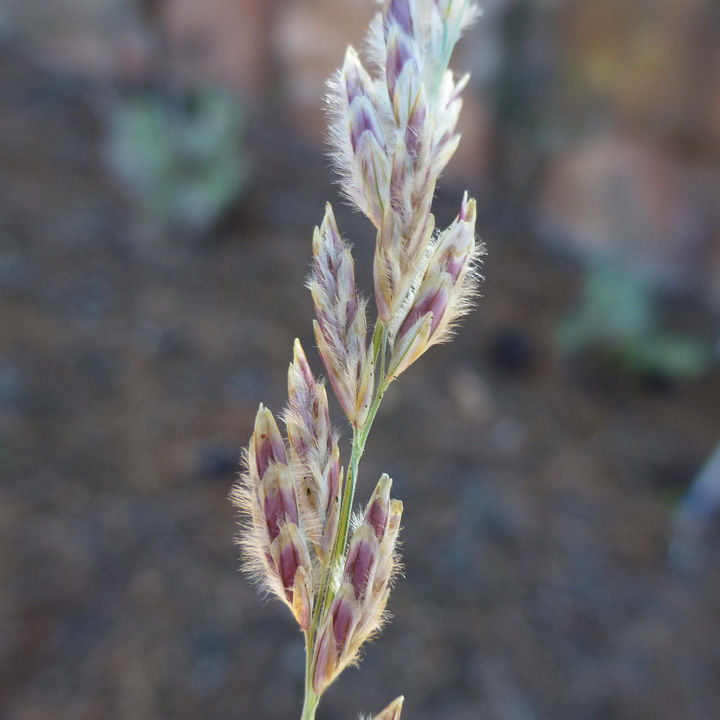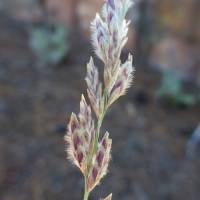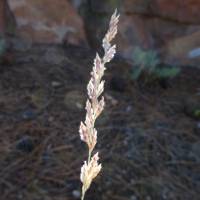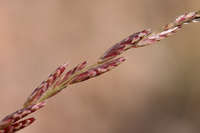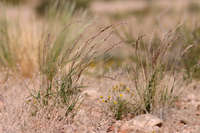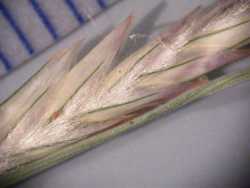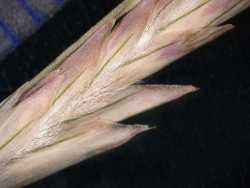Plants cespitose, with knotty, shortly rhizomatous bases. Culms 20-80 cm; nodes often with soft, 1-2 mm hairs. Sheaths rounded, lower sheaths often strigose or pilose, upper sheaths glabrous or scabrous; ligules 0.5-1 mm, membranous, ciliate; blades 1-4 mm wide, usually involute or loosely infolded, glabrous, scabrous, or sparsely pilose, attenuate distally. Panicles 7-20(25) cm long, 0.3-0.8 cm wide; branches erect, spikelets imbricate but usually not crowded; pedicels 1-2 mm. Spikelets 8-13 mm, with 5-11 florets. Glumes glabrous, usually purple-tinged; lower glumes 3-8(10) mm, 1-3-veined; upper glumes 4-10 mm, 1-7-veined; lemmas 3.5-7 mm, usually purple-tinged, midveins pilose on the basal 1/3-1/2, rarely excurrent, lateral veins pilose to well above midlength, never excurrent; paleas 1-2 mm shorter than the lemmas, margins pubescent; anthers 1-1.5 mm. Caryopses 1.5-2.3 mm. 2n = 40.
Perennials, Terrestrial, not aquatic, Stems nodes swollen or brittle, Stems erect or ascending, Stems caespitose, tufted, or clustered, Stems terete, round in cross section, or polygonal, Stem nodes bearded or hairy, Stem internodes hollow, Stems with inflorescence less than 1 m tall, Stems, culms, or scapes exceeding basal leaves, Leaves mostly basal, below middle of stem, Leaves mostly cauline, Leaves conspicuously 2-ranked, distichous, Leaves sheathing at base, Leaf sheath mostly open, or loose, Leaf sheath smooth, glabrous, Leaf sheath hairy, hispid or prickly, Leaf sheath and blade differentiated, Leaf blades linear, Leaf blades very narrow or filiform, less than 2 mm wide, Leaf blades 2-10 mm wide, Leaf blade margins folded, involute, or condupl icate, Leaf blades mostly glabrous, Leaf blades more or less hairy, Ligule present, Ligule a fringe of hairs, Inflorescence terminal, Inflorescence a contracted panicle, narrowly paniculate, branches appressed or ascending, Inflorescence solitary, with 1 spike, fascicle, glomerule, head, or cluster per stem or culm, Inflorescence spike linear or cylindric, several times longer than wide, Inflorescence with 2-10 branches, Inflorescence branches more than 10 to numerous, Flowers bisexual, Spikelets pedicellate, Spikelets laterally compressed, Spikelet less than 3 mm wide, Spikelets with 3-7 florets, Spikelets with 8-40 florets, Spikelets solitary at rachis nodes, Spikelets all alike and fertille, Spikelets bisexual, Spikelets disarticulating above the glumes, glumes persistent, Spikelets disarticulating beneath or between the florets, Rachilla or pedicel glabrous, Glumes present, empty bracts, Glumes 2 clearly present, Glumes equal or subequal, Glumes equal to or longer than adjacent lemma, Glumes keeled or winged, Glumes 1 nerved, Glumes 3 nerved, Glumes 4-7 nerved, Lemmas thin, chartaceous, hyaline, cartilaginous, or membranous, Lemma 3 nerved, Lemma body or surface hairy, Lemma apex acute or acuminate, Lemma apex dentate, 2-fid, Lemma awnless, Lemma straight, Callus or base of lemma evidently hairy, Callus hairs shorter than lemma, Palea present, well developed, Palea membranous, hyaline, Palea about equal to lemma, Palea 2 nerved or 2 keeled, Stamens 3, Styles 2-fid, deeply 2-branched, Stigmas 2, Fruit - caryopsis.
Common Name: slim tridens
Duration: Perennial
Nativity: Native
Lifeform: Graminoid
General: Small perennial bunchgrass 20-50 cm tall, stout, with knotty, shortly rhizomatous bases.
Vegetative: Sheaths open, rounded, upper sheaths glabrous, lower usually pilose; blades mostly 8-15 cm long, involute or occasionally flat, often glaucous; collar and ligule mostly long-hairy; ligule ciliate with fused base, 0.5-1 mm long, with membranous lateral aur
Inflorescence: Contracted panicle or raceme, 6-20 cm, narrow and spikelike, spikelets rather distant, not crowded; spikelets 9-13 mm long and 5-10 flowered; glumes broadly lanceolate or ovate, very thin and hyaline, one-nerved, the second glume rarely with short lateral nerve stubs; lemmas about as long as glumes, thin, hyaline or deeply tinged with purple, apex broadly rounded, occasionally notched or mucronate. Disarticulation above the glumes.
Ecology: Dry plains, rocky slopes, grasslands, and woodlands; below 5,500 ft (1676 m); flowers May-September.
Distribution: s CA, s NV, AZ and UT, west to TX, KS, MO and OK; south to s MEX.
Notes: Distinguished as a small perennial bunchgrass, to 50 cm tall, with a contracted, spike-like inflorescence bearing multi-flowered spikelets, each with a purple lemma, giving the spikelets horizontal purple or white stripes. Each floret is long-hairy on veins and rounded to truncate, sometimes with a notch at the apex. When mature, seeds drop off, leaving a pair of paper-like scales (glumes) that persist through the year. Var. muticus can be distinguished by its upper glumes 4-6 mm long, 1-veined. Var. elongatus is distinguished by its upper glumes being 5.5-10 mm long and 3-7 veined. Both varieties are found in the US Southwest.
Ethnobotany: Used as fodder.
Etymology: Tridens means three-toothed, referring to the three shortly excurrent veins on the lemmas of Tridens flavus, the type species; muticus means blunt or without a point, possibly referring to the shape of the lemmas on this species.
Synonyms: Triodia mutica
Editor: SBuckley 2010, FSCoburn 2014, AHazelton 2015


